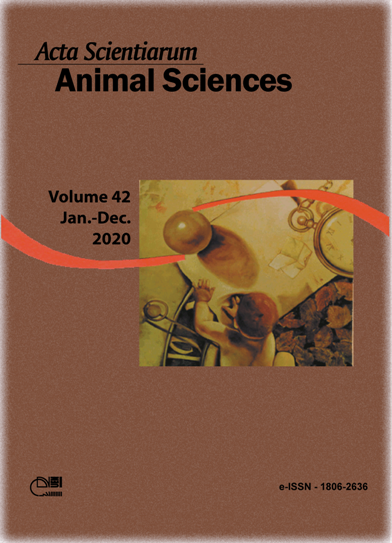Exploratory data inference for detecting mastitis in dairy cattle
Abstract
The aim of this study was to employ the principal component technique to physiological data and environmental thermohygrometric variables correlated with detection of clinical and subclinical mastitis in dairy cattle. A total of 24 lactating Girolando cows with different clinical conditions were selected (healthy, and with clinical or subclinical mastitis). The following physiological variables were recorded: udder surface temperature, ST (°C); eyeball temperature, ET (°C); rectum temperature, RT (°C); respiratory frequency, RF (mov. min-1). Thermohygrometric variables included air temperature, AirT (°C), and relative humidity, RU (%). ST was determined by means of thermal images, with four images per animal, on these quarters: front left side (FL), front right side (FR), rear right side (RR) and rear left side (RL), totaling 96 images. Exploratory data analysis was run through multivariate statistical technique with the employment of principal components, comprehending nine variables: ST on the FL, FR, RL and RR quarters; ET, RT; RF, AirT and RU. The representative quarters of the animals with clinical and subclinical mastitis showed udder temperatures 8.55 and 2.46° C higher than those of healthy animals, respectively. The ETs of the animals with subclinical and clinical mastitis were, respectively, 7.9 and 8.0% higher than those of healthy animals. Rectum temperatures were 2.9% (subclinical mastitis) and 5.5% (clinical mastitis) higher compared to those of healthy animals. Respiratory frequencies were 40.3% (subclinical mastitis) and 61.6% (clinical mastitis) higher compared to those of healthy animals. The first component explained 91% of the total variance for the variables analyzed. The principal component technique allowed verifying the variables correlated with the animals' clinical condition and the degree of dependence between the study variables.
Downloads
References
Digiovani, D. B., Borges, M. H. F., Galdioli, V. H. G., Matias, B. F., Bernardo, G. M., Silva, T. R., ... Júnior, C. K. (2016). Infrared thermography as diagnostic tool for bovine subclinical mastitis detection. Revista Brasileira de Higiene e Sanidade Animal, 10(4), 685-692. doi: 10.5935/1981-2965.20160055
Figueiredo Filho, D. B., & Silva Júnior, J. A. (2009). Desvendando os mistérios do coeficiente de correlação de Pearson. Revista Política Hoje, 18(1). doi: 10.11606/issn.2237-4485.lev.2014.132346
Gloster, J., Ebert, K., Gubbins, S., Bashiruddin, J., & Paton, D. J. (2011). Normal variation in thermal radiated temperature in cattle: implications for foot-and-mouth disease detection. BMC Veterinary Research, 7(73), 1-10. doi: 10.1186/1746-6148-7-73
Johnson, S. R., Rao, S., Hussey, S. B., Morley, P. S., & Traub-Dargatz, J. L. (2011). Thermographic eye temperature as an index to body temperature in ponies. Journal of Equine Veterinary Science, 31(2), 63-66. doi: 10.1016/j.jevs.2010.12.004.
Jolliffe, I. T. (1973). Discarding variables in a principal component analysis. II: Real data. Journal of the Royal Statistical Society: Series C (Applied Statistics), 22(1), 21-31. doi: 10.2307/2346300
Kessel, L., Johnson, L., Arvidsson, H., & Larsen, M. (2010). The relationship between body and ambient temperature and corneal temperature. Investigative Ophthalmology & Visual Science, 51(12), 6593-6597. doi: 10.1167/iovs.10-5659
Langoni, H., Salina, A., Oliveira, G. C., Junqueira, N. B., Menozzi, B. D., & Joaquim, S. F. (2017). Considerations on the treatment of mastitis. Pesquisa Veterinária Brasileira, 37(11), 1261-1269. doi: 10.1590/s0100-736x2017001100011
Paiva, A. L. C., Teixeira, R. B., & Yamaki, M. (2010). Análise de componentes principais em características de produção de aves de postura. Revista Brasileira de Zootecnia, 39(2), 285-288. doi: 10.1590/S1516-35982010000200007
Pezeshki, A., Stordeur, P., Wallemacq, H., Schynts, F., Stevens, M., Boutet, P., ... Bureau, F. (2011). Variation of inflammatory dynamics and mediators in primiparous cows after intramammary challenge with Escherichia coli. Veterinary Research, 42(15), 1-10. doi: 10.1186/1297-9716-42-15
Polat, B., Colak, A., Cengiz, M., Yanmaz, L. E., Oral, H., Bastan, A., ... Hayirli, A. (2010). Sensitivity and specificity of infrared thermography in detection of subclinical mastitis in dairy cows. Journal of Dairy Science, 93(8), 3525-3532. doi: 10.3168/jds.2009-2807
Redaelli, V., Bergero, D., Zucca, E., Ferrucci, F., Costa, L. N., Crosta, L., & Luzi, F. (2014). Use of thermography techniques in equines: principles and applications. Journal of Equine Veterinary Science, 34(3), 345-350. doi: 10.1016/j.jevs.2013.07.007
Stewart, M., Wilson,M.T., Schaefer, A.L., Huddart, F., & Sutherland, M.A. (2017).The use of infrared thermography and accelerometers for remote monitoring of dairy cow health and welfare. Journal of Dairy Science, 100 (5), 3893-3901. doi: 10.3168/jds.2016-12055
Vliegher, S., Fox, L., Piepers, S., McDougall, S., & Barkema, H. (2012). Invited review: Mastitis in dairy heifers: Nature of the disease, potential impact, prevention, and control. Journal of Dairy Science, 95(3), 1025-1040. doi: 10.3168/jds.2010-4074
DECLARATION OF ORIGINALITY AND COPYRIGHTS
- I Declare that current article is original and has not been submitted for publication, in part or in whole, to any other national or international journal.
The copyrights belong exclusively to the authors. Published content is licensed under Creative Commons Attribution 4.0 (CC BY 4.0) guidelines, which allows sharing (copy and distribution of the material in any medium or format) and adaptation (remix, transform, and build upon the material) for any purpose, even commercially, under the terms of attribution.
Read this link for further information on how to use CC BY 4.0 properly.








































